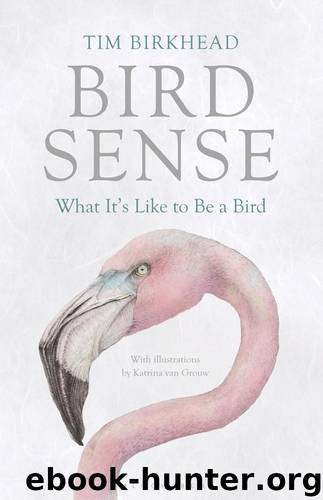Bird Sense by Tim Birkhead

Author:Tim Birkhead
Language: eng
Format: epub
Publisher: Bloomsbury USA
Published: 2012-01-11T05:00:00+00:00
In 1989, Jack Dumbacher, a PhD student at the University of Chicago, made a remarkable discovery: he found the world’s first distasteful bird. Jack was studying Raggiana birds of paradise in Varirata National Park, Papua New Guinea. He and his fellow students set nets to catch their birds of paradise, but, as often happens, they caught other species as well. One of the commonest bi-catch species was the hooded pitohui (phonetically: pit-oh-wheez), a bird with striking orange and black plumage. The pitohui were a nuisance, not least because they smelled and were always feisty on being removed from the net. On one occasion a bird scratched Dumbacher as he was handling it, breaking the skin. Not long after, while sucking the wound, Dumbacher became aware that his mouth had become numb. At the time he thought little of it, but when another student reported the same thing some time later he began to wonder if there was something special about the pitohui. There wasn’t time that season to check, but the following year Jack took a single feather from a pitohui he had just caught and tasted it. The effect was electric. There was something extraordinarily unpleasant on the feathers.
When Bruce Beehler, Dumbacher’s PhD supervisor, visited a few months later, Dumbacher told him what he had found, wondering modestly whether it might make an interesting note for a local bird journal. Beehler erupted: ‘Are you telling me you’ve found a poisonous bird? . . . This should be on the cover of Science ! Turn the car around! We’re going back to town to get permission to study this bird!’
Bruce Beehler probably knows more about New Guinea birds than almost anyone else – he wrote the definitive Birds of New Guinea – and he recognised immediately that Dumbacher had made an extraordinary discovery. He was amazed that no one had previously commented on the hooded pitohui’s toxic feathers – the species had been known to science since the mid-1800s, it was common locally and there were dozens of skins in museums across the world.
In fact the local people did know all about the hooded pitohui – they called it the wobob, which literally means ‘the bird whose bitter skin puckers the mouth’. It was one of Dumbacher’s colleagues who told him that the pitohui’s unpleasant taste had previously been described in ‘an old book’ written by a New Zealand anthropologist, Ralph Bulmer, with a local man, Ian Seam Majnep. Old? When I checked, I discovered that the book had been published as recently as 1977. When Dumbacher checked, he was surprised to learn that, in addition to the wobob, local people knew of yet another distasteful New Guinea bird, this one from the highlands: the blue-capped ifrita (a species that behaves like a nuthatch), known locally as slek-yakt, meaning ‘bitter bird’.17
Dumbacher wondered what the toxin on the feathers of these birds was and, by an extraordinary stroke of luck, was directed to the only person in the world who could help him find out.
Download
This site does not store any files on its server. We only index and link to content provided by other sites. Please contact the content providers to delete copyright contents if any and email us, we'll remove relevant links or contents immediately.
Photographic Guide to the Birds of Indonesia by Strange Morten;(2408)
The Big Twitch by Sean Dooley(2319)
7-14 Days by Noah Waters(2249)
Identifying Birds by Colour by Norman Arlott(2135)
Tippi by Tippi Hedren(2099)
Birds of the Pacific Northwest by Shewey John; Blount Tim;(1875)
Raptors by Traer Scott(1542)
The Path Between the Seas by David McCullough(1511)
Bald Eagles In the Wild by Jeffrey Rich(1423)
Life on Earth by David Attenborough(1372)
Skin by Unknown(1300)
How to Speak Chicken by Melissa Caughey(1266)
Nest by Janine Burke(1215)
The Feather Thief by Kirk Wallace Johnson(1194)
Life List by Olivia Gentile(1130)
Birds of New York City by Cal Vornberger(1129)
H Is for Hawk by Helen Macdonald(1122)
RSPB Pocket Guide to British Birds by Simon Harrap(1098)
The Peregrine by J. A. Baker(1062)
